Lecture 18: introduction to nerve cells and excitability 2
1/28
There's no tags or description
Looks like no tags are added yet.
Name | Mastery | Learn | Test | Matching | Spaced |
|---|
No study sessions yet.
29 Terms
how do neurons communicate between eachother?
through dendrites and axons
incoming signals are received at dendrites
the cell body(soma) processes and integrates this information
then the axon carries the information along a long distance from 1 end of the neuron to the other
the nerve terminals transmit the information
what is resting membrane potential?
Difference in electrical charge across the membrane at rest
what are action potentials?
a brief change in the voltage across the membrane due to the flow of certain ions into and out of the neuron
how is rapid communication achieved through the long axon?
the neuron senses the electrical signals from the cell body to the nerve terminals also known as AP.
this mechanism of cellular communication is responsible for cutaneous sensations and also responsible for your ability to read
the entire functioning of the nervous system is dependent upon action potentials and the resulting release of chemical messengers
feature of neurons:
they are polarised meaning there is an electrical voltage across the cell membrane
in a resting neuron, the RMP is -70mV
due to conc gradients of sodium and potassium across the cell membrane: more sodium outside the cell and more potassium inside the cell
gradients are maintained by sodium-potassium pump which constantly pumps K+ in and Na+ out
features of APs:
large transient changes in membrane potential
very rapid
depend on several types of membrane ion channels
also known as spikes/nerve impulses
how is a neuron stimulated?
typically stimulated at dendrites and the signal spreads through the soma
1. excitatory signals at dendrites open ligand-gated sodium channels and allow sodium to flow into the cell
this neutralises some of the negative charge inside the cell and makes the membrane less negative - this is known as depolarisation as the cell membrane becomes less polarised
2. the influx of sodium diffuses inside the neuron and produces a current that travels towards the axons hillock
the axons hillock is also known as the cells 'trigger zone' as this is where action potentials usually start because APs are produced by VG ion channels which are most concentrated at the hillock
3. based on the strength of the incoming situation, the neuron must decided wether to pass the signal along or not -
if the stimulation is strong enough the signal is transmitted along the entire length of the axon in a phenomenon attack called an aciton potential - when this happens, its said the neuron fires
what is the all or none law
there is no such thing as a 'strong' or 'weak' action potential - the AP is always a full response
once threshold is reached, an action potential will be fired regardless of the strength of the stimulus
This is important for consistent and reliable signal transmission in neurons.
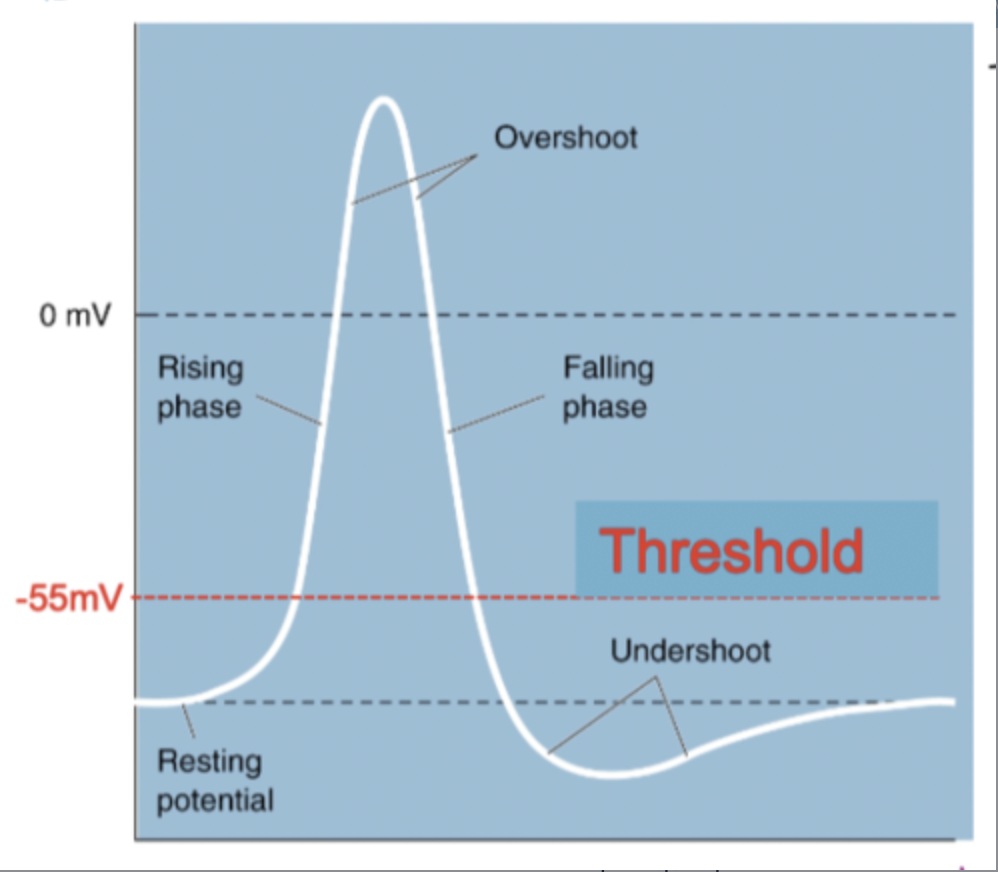
what are the phases of action potentials
all relative to the resting membrane potential -70mV
hypopolarisation: the inital increase of the membrane potential to the value of the threshold potential(the threshold potential opens voltage gated sodium channels and causes a large influx of sodium ions(depolarisation))
depolarisation: the potential moving from RMP to less negative values( the inside of the cell gets more electropositive until the equilibrium reaches +
overshoot: the peak of the action potential reached at about +40 mV
repolarisation: the potential moving back to the resting membrane potential of -70mV
hyperpolarisation/undershoot: the potential moving away from the resting membrane potential in a more negative direction
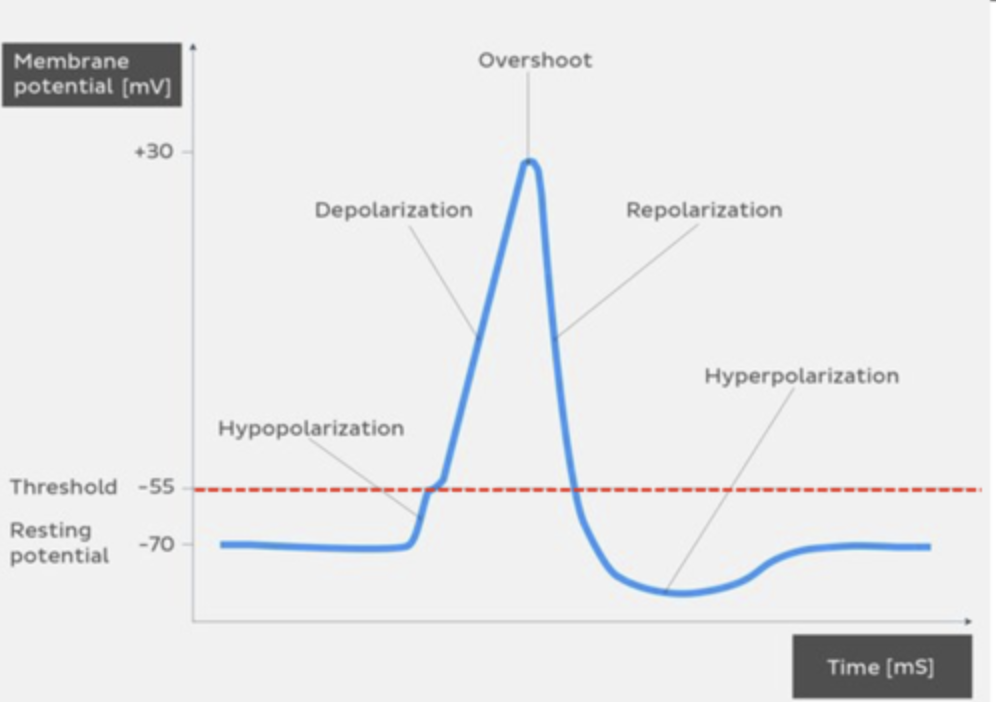
how do ion channels work in membrane potential?
permanently open pore
sets RMP
not involved in AP
ions move through passive diffusion down conc gradient
some always open(leaky) some need signal(voltage gated)
only open at specifc MP
what are the features of voltage gated channels?
only opens at specific conditions
closed as RMP
only open when membrane is depolarised
responsible for initiation(Na+) and Termination(K+) of AP
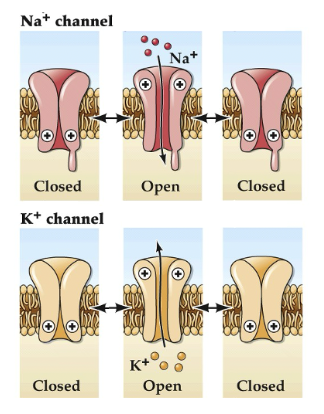
when do Na+ VG channels open?
-55 mV
allow Na+ to move in
closes as we move away from -55
when do K+ VG channels open?
+ 30 mV
allow K+ to move out
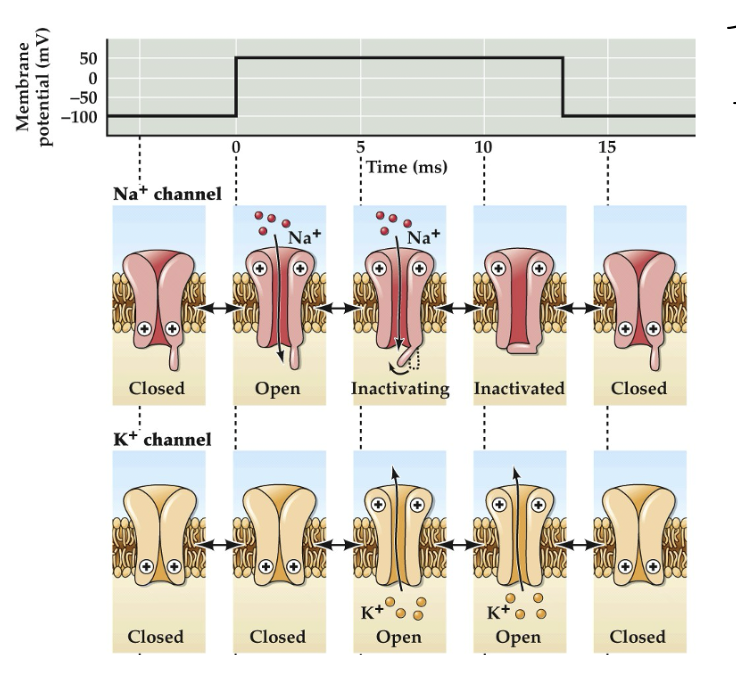
how is the RMP slowly restored over time
at threshold(-55), Na+ channels open quickly causing Na+ influx
at 0, the Na+ ions rush into the cell so the inside becomes more positive, depolarising the cell membrane. (increasing voltage causes more Na+ ion channels to open)
this positive feedback continues untill all the Na+ channels open (till 30)
As the AP nears the peak, Na+ channels close and K+ channels open
K+ ions rush out of the cell and voltage goes back to resting value, this is repolarisation(switch places)
K+ gates are slow to close so K+ continues to leave causing negative overshooting, hyperpolarisation

what are refractory periods?
The refractory period is the time after an action potential when a neuron is either unable or less able to fire another action potential
absolute refractory period
relative refractory period
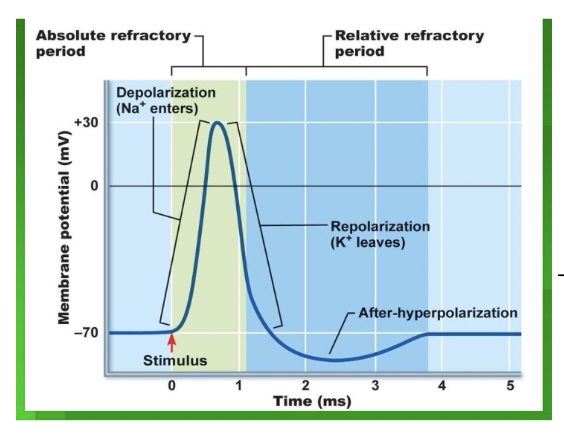
what is the absolute refractory period?
The absolute refractory period is when no second action potential can occur, due to inactivated sodium channels.
VGNC are inactive and cant be activated until membrane is repolarised and resting state is restored
what is the relative refractory period?
membrane potential is hyperpolarised by VGKC
ap can be generated if the stimulus strength is strong enough to overcome hyperpolarisation to reach threshold
last till end of hyperpolarisation
K+ channels still open, making it difficult for membrane to depolarise
The relative refractory period is when a stronger-than-usual stimulus is needed to trigger another action potential because potassium channels are still open.
how are action potentials propagated?pt1
stimulation exceeds threshold for an AP at node of ranvier A
produces opening of more Na+ channels( at -55)
membrane is already positive, K+ start to open
local current along inside axon without leak

how are action potentials propagated?pt2
local current opens VGNC at axon hillock and generates AP at node B
VGNC inactivation and open VGKC prevent back- propagation to node A$

how are action potentials propagated?pt3
process repeated at node C- AP jumps in one direction down the axon at high speed without decrement
K+ channels now open
can move left or right but point a is already active so goes to point C

what does the velocity of propagation depend on?
diameter and myelination of axon
large axons have less resistance to local current so the larger the diameter the faster the propagation
myelin electrically insulates large areas of axon allowing the local currents to spread faster and further increasing speed of propagation
VG only at nodes of ranvier
what are the 2 main principles for speed of AP?
Big and myelinated
what is the process of saltatory conduction? pt1
why is pain one of the slowest sensations?
smaller fibres without myelin carry signals slowly
fastest signals in our bodies are sent by larger myelinated axons found in neurons that transmit the sense of touch(proprioceptors
what are the demylination diseases?
Guillain-Barre syndrome: destruction of schwann cells in PNS(produce myelin outside CNS)
multiple sclerosis: caused by lose of oligodendrites( in brain and spinal cord)- produce myelin in CNS
both involve muscle weakness and numbness
what happens when the myelin coat of the nerves degenerates?
signals are destroyed
if the nerves are afferent then destruction of myelin leads to numbness or tingling as the sensations arent travelling as they should
if nerves are efferent, leads to weakness as the brain is expending energy but still unable to move affected limbs
limbs especially affected why?
longest nerves
the longer the nerve, the more myelin it has that can be destroyed
what are graded potentials?
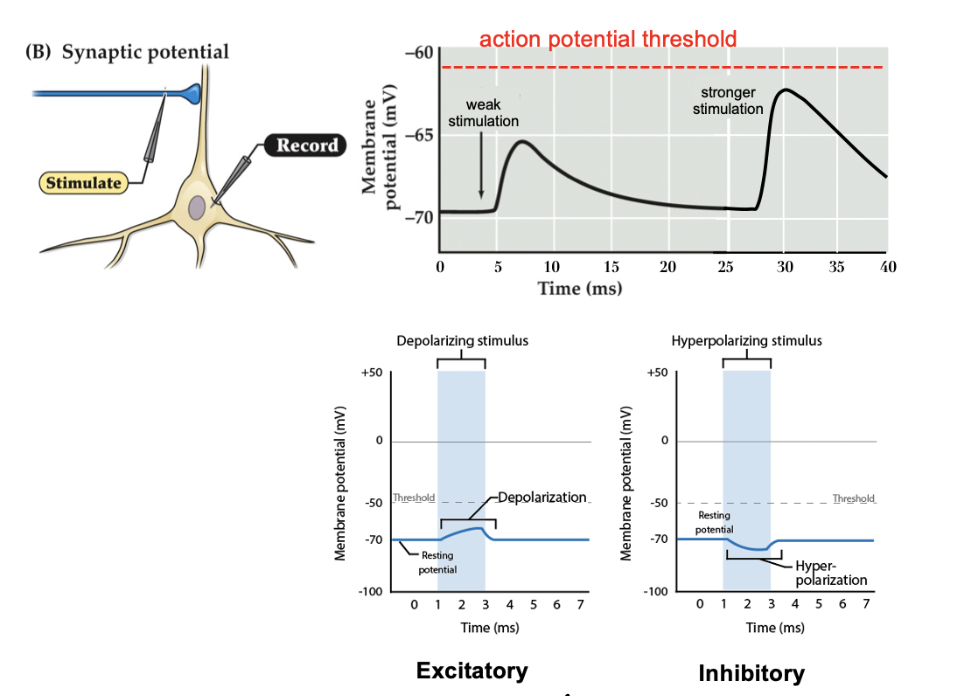
what are the types of graded potentials?
Graded potentials are small, localized changes in membrane potential that vary in size depending on the strength of the stimulus. (1 mark)
Main types: Depolarizing (excitatory) (½ mark) and hyperpolarizing (inhibitory) (½ mark)
Differences from action potentials (2 of the following – ½ mark each):
Not all or none
They decrease with distance (decremental)
Used in short-range communication, such as at synapses
